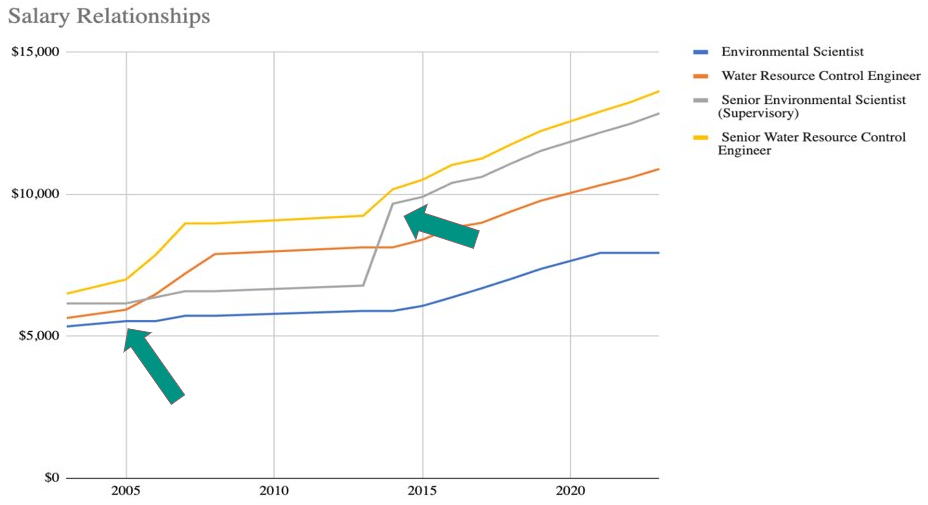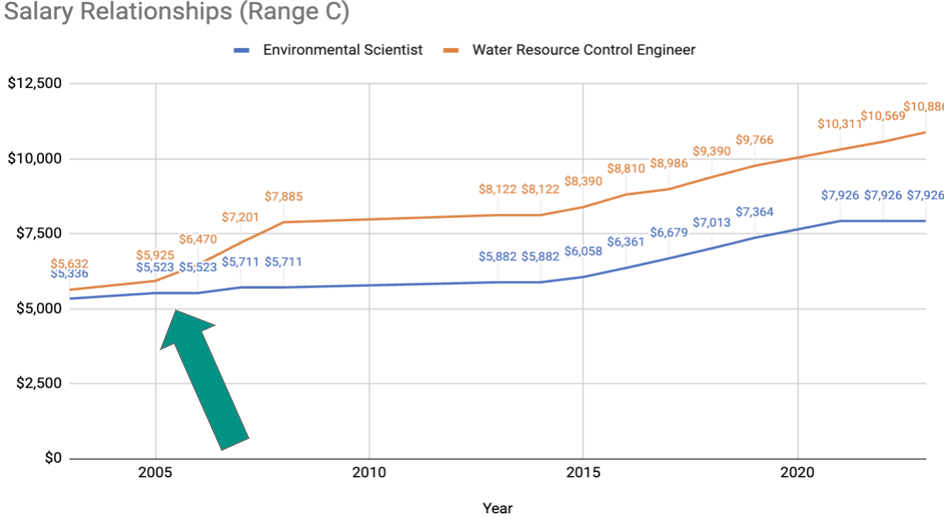Between 1984 and the early 2000s, contract agreements reached with Unit 10 demonstrated that the State valued and placed a priority on the work scientists do.
The agreements also illustrated that the State connected compensation and benefits to recruiting and retaining the scientific talent needed to accomplish the missions of the various Agencies that employ State Scientists.
The Timeline
- During this time period, compensation for State Scientific and State Engineering positions were nearly interchangeable and relatively equal.
- The collective bargaining agreements between Bargaining Unit 9 (State Engineers) and Bargaining Unit 10 (State Scientists) mirrored each other on alternating-year schedules. When one unit bargained a certain salary increase, the next year, the other would “catch up” or slightly surpass the other.
- This equity between units was maintained until 2003.
- Within this timeframe, the engineers in Unit 9 ratified an agreement (2003) with an Administration that was recalled.
- Thus, the long-standing pay relationship between engineers and scientists was broken as Unit 10 was unable to finalize a similar Agreement with the new Administration that would have preserved the pay relationships between engineers and scientists.
- Additionally, California then experienced an economic downturn. As a result, all state employees were furloughed for several years (2008-2013), which made securing an equitable agreement virtually impossible.
Like Pay for Like Work
- As a result of the pay relationship disruption, CAPS pursued an administrative remedy to rectify the broken pay relationship for 14 supervisory scientist classifications.
- The argument was based on the Government Code 19826 principle that “like salaries shall be paid for comparable duties and responsibilities.”
- The suit successfully demonstrated that work in similar or comparable state scientific and engineering classifications should be valued equally. The conclusion of the case: the same work requires the same pay.
- The Dills Act precludes rank-and-file scientists from being able to sue on an issue like this. All benefits, including wages, have to be negotiated at the bargaining table for rank-and-file state workers: even when the State is violating their own laws & policies.
- This LPLW case recognized that Unit 10 and Unit 9 supervisors and managers do equivalent work, which makes the case for the rank-and-file employees as well, but the State did not adjust Unit 10 rank-and-file salaries as they did the managers’.
Supervisor and Manager Pay Letter Issued.
CalHR issued a Pay Letter on August 20, 2014 that:
- Fully funded appropriate salary adjustments for the 14 state supervisory scientist classifications covered by the lawsuit.
- Supervisory scientist classifications received pay adjustments of up to 43%, overnight.
- As a result, salary adjustments for scientific- and engineering-related managerial classifications were made.
Present Day
- Fast forward to 2023: Environmental Scientists and Engineers continue to perform comparable duties, but salaries for rank-and-file Scientists in Unit 10 have STILL not been adjusted, which has resulted in major disruptions throughout the environmental programs State Scientists lead.
- The Newsom Administration continues to ignore the impacts this is having on rank-and-file State Scientists.
- The Newsom Administration makes great effort to maintain the pay relationships between units at the supervisory level and above, as well as the in-unit relationships in Unit 9, but this is not the case for Unit 10 rank-and-file scientists.
- This has caused decaying morale and resentment among State Scientists and their teams—ultimately making the mission to protect Californians and the environment less effective.
- This has encouraged new hires and seasoned scientists in critical programs to leave the department within a few years of receiving training.
- They change classification to Bargaining Unit 9, or to local or federal agencies, that provide fair pay.
- The Governor has made record investments for environmental and public health initiatives, where rank-and-file scientists do a majority of this work, yet there hasn’t been a commensurate investment in the actual scientists who serve California.
- Bargaining has not corrected the disparity that was created through this Administrative action. The incremental progress has not addressed the collapse of the pay similarity between State Engineers and State Scientists.
- Historically Scientists and Engineers were compensated relatively equally for over 20 years, prior to 2003. That is no longer the case, even though everything else has remained the same: our responsibilities, our working relationships, our reporting structures – everything is as it was.
- CAPS continues to seek to re-establish the appropriate historical salary relationships for ALL State Scientists in Unit 10.

- Prior to the release of the 2014 Pay Letter that appropriately adjusted Unit 10 supervisory classifications to meet compliance with the Like Pay for Like Work Ruling, the Unit 10 classification series relationship was logical.
- As you can see by looking at the light blue line on the graph above, in 2014, many Unit 10 managers and supervisors received pay adjustments of up to 43% overnight as a result of the LPLW lawsuit in recognition of doing similar and comparable work to that of engineers.
- Disruption of the Unit 10 salary structure over the years has resulted in large anomalous gaps in pay between managers/supervisors and rank-and-file staff.
- The standard salary structure between rank-and-file scientists and their supervisors & managers worked well for Unit 10 for 30 years before 2014. Prior to 2014 the gap between the rank-and-file scientist and their supervisor was approximately 15%. In 2023, it is 62%, and is expected to increase after the Bargaining Unit 9 contract was ratified last year.
- These large gaps don’t exist in other State bargaining units and clearly violate the state’s own Internal Salary Relationship policies.

- This graph illustrates an obvious divergence of a previously parallel compensation.
- The historical salary relationships were logical and recognized equal pay value for the equal-valued work being done. At some points, Environmental Scientists were even being paid more than environmental engineers, and as a result, engineers would move into the Environmental Scientist classification so they could be paid more. The salary relationship between classifications were always within 5% of each other.
- As you can see here in 2005 there was a large increase for engineers, as their salaries were adjusted to be competitive with the marketplace.
- That same adjustment is necessary for rank-and-file scientists in order to be able to recruit and retain talented individuals to perform critical and necessary work for the state so it can continue to lead with science.
- Even though scientists and engineers still do the same work, in 2023, scientists make 37% less than our unlicensed engineering counterparts.
Over the years, thousands of stakeholders, including agency secretaries, department directors, the Legislative Analysts Office, Former DPA Director Ron Yank, and Former California Senator Barbara Boxer have advocated for this pay equity issue to be fixed. Even CalHR’s own Total Compensation report spoke up on this ongoing issue in 2006 and how it needs to be addressed. Even with all of this input & all of these stakeholders speaking up, including their own organization, this Administration is still ignoring it. It’s illogical, it’s disrespectful and it’s leading to issues that are serious to California’s public health and the environment, as the State is unable to retain or attract qualified Scientists.
